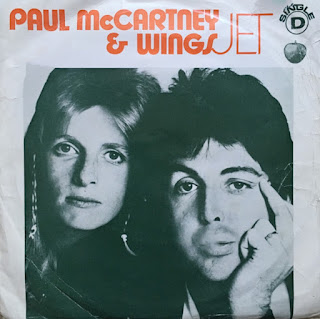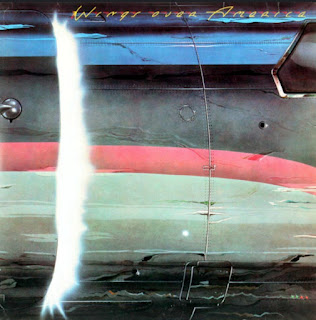JET
Publicació: 28 de gener de 1974 (EUA) 15 de febrer de 1974 (Regne Unit)
Llistes: Regne Unit: #7 EUA: #7
"Jet", el segon tema del disc “Band on the Run”, va ser el primer senzill llançat des de l'àlbum. Inicialment, "Jet" es va emparellar amb "Mamunia" com a cara B. No obstant, tres setmanes més tard, "Let Me Roll It" va substituir "Mamunia" al senzill.
Inicialment, a Paul McCartney no li agradava que es publiquesin singles de "Band On The Run". Malgrat això, el locutor de ràdio Al Coury el va convèncer que "Jet" funcionaria bé com a senzill. McCartney, dividit entre la integritat artística i les consideracions comercials, va expressar la seva reticència dient: "Però de vegades, només he de recordar que això no és una botiga de discs que estic gestionant; això suposadament ha de ser una mena d'art. I si no encaixa, no encaixa."
La durada original de "Jet" era de més de quatre minuts, considerada massa llarga per a la ràdio. En conseqüència, McCartney va permetre a contracor que Capitol Records creés una versió editada, reduint-ne la durada a 2 minuts i 49 segons. Aquesta versió editada es va llançar com a senzill promocional en mono.
"Jet" va rebre el nom d'un poni negre propietat de Paul i Linda McCartney. La llar dels McCartney albergava diversos animals, com ara un gos anomenat Poppy, un dàlmata anomenat Lucky i la vella gossa pastora Martha. La elecció de "Jet" pel títol de la cançó va estar influïda per la seva qualitat apta per a estadi, la qual la feia adequada per a la participació entusiasta del públic en els estadis. La pròpia cançó és una reflexió sobre la llibertat, i Paul McCartney té l'hàbit d'utilitzar títols poc convencionals, com una atracció d'un parc temàtic a "Helter Skelter", per transmetre els seus conceptes musicals. Linda McCartney va aportar informació sobre la creació de la cançó, destacant la intenció de Paul de fer-la "totalment esbojarrada" expressant la seva satisfacció per experimentar a l'estudi.
La frase "I thought the Major was a lady suffragette" pot tenir una certa ambigüitat, però val la pena assenyalar que la cançó "Suffragette City" de David Bowie es va llançar l'any anterior. El terme "suffragette" fa referència a una dona que advoca pel dret a votar, i la seva presència a la lletra de McCartney podria estar influïda pel context cultural més ampli on aquest terme estava en plena actualitat.
"Jet" es va enregistrar als estudis AIR de George Martin a Londres després que la banda tornés d'enregistrar la major part de "Band On The Run" a Lagos, Nigèria. La gravació de "Jet" va incloure Howie Casey al saxofon. Casey, que havia estat membre de Derry And The Seniors, un grup de Liverpool de l'època del Cavern Club, tenia connexions amb The Beatles i també va contribuir a altres cançons de l'àlbum "Band On The Run", com ara "Bluebird" i "Mrs Vandebilt".
LET ME ROLL IT
Estrena: 30 de novembre de 1973
"Let Me Roll It" és una cançó del seu àlbum de 1973 "Band on the Run". Servint com a cançó de tancament de la primera cara del disc, també va esdevenir el revers del senzill "Jet" a principis de 1974. La cançó ha mantingut la seva presència a les actuacions en viu de McCartney des de la seva publicació. Destacablement, "Let Me Roll It" ha estat vista com un homenatge a l'estil de producció minimalista del treball de John Lennon, especialment de l'àlbum John Lennon/Plastic Ono Band i del senzill "Cold Turkey".
Paul McCartney va escriure "Let Me Roll It" a High Park Farm, a Escòcia. Tot i que qualsevol semblança amb l'àlbum en solitari debut de John Lennon es va considerar coincident, l'ús de l'eco, el baix i una guitarra solista que destacaven per damunt de la resta d’instruments, va portar a comparacions amb la feina de Lennon. Mentre que l'estil vocal podria recordar a John, McCartney va destacar el paper crucial que jugava el riff de guitarra penetrant. Va descriure l'impacte dramàtic d'aquest riff en l'audiència, causant un moment de temps congelat amb el seu final abrupte.
McCartney va aclarir en una entrevista del 2010 amb la revista Clash que "Let Me Roll It" no era específicament una branca d'olivera cap a John Lennon, sinó més aviat una cançó inspirada en les drogues. Va explicar que l'estil de la cançó es semblava al que utilitzaven amb The Beatles, que s'associava amb Lennon. McCartney va destacar l'ús de l'eco a la cançó, afirmant que no es tractava d'evitar-lo només perquè Lennon ho feia. Va revelar que el doble sentit de la lletra parlava de l'acció de liar un porro.
Tot i les descripcions ocasionals de "Let Me Roll It" com una resposta a "How Do You Sleep?" de Lennon, la biografia autoritzada de Philip Norman, "Paul McCartney: The Life", explica una perspectiva diferent. Segons la biografia, McCartney i Lennon es van trobar el 1972, després del llançament de “Imagine” i abans de “Band on the Run”, i van acordar que criticar-se mútuament a través d'àlbums o la premsa musical no era necessari. Posteriorment Lennon va reconèixer que “Band on the Run” era un gran àlbum.
La frase "Let me roll it to you" va ser inspirada per una frase de la cançó de George Harrison "I'd Have You Anytime", la primera pista del seu àlbum de 1970 "All Things Must Pass".
PAUL McCARTNEY & WINGS - JET / LET ME ROLL IT
JET
Released : January 28, 1974 (US) February 15, 1974 (UK)
Charted: UK: #7 US: #7
"Jet," the second track of the Band on the Run LP, served as the first single released from the album. Initially, "Jet" was paired with "Mamunia" as the B-side. However, after three weeks, "Let Me Roll It" replaced "Mamunia" as the B-side of the single.
Initially, Paul McCartney didn't want any singles to be released from "Band On The Run." However, radio plugger Al Coury convinced him that "Jet" would work well as a single. McCartney, torn between artistic integrity and commercial considerations, expressed his struggle, saying, "But sometimes, I just have to remember that this isn’t a record store I’m running; this is supposed to be some kind of art. And if it doesn’t fit in, it doesn’t fit in."
The original length of "Jet" was over four minutes, deemed too long for radio play. Consequently, McCartney reluctantly allowed Capitol Records to create an edited version, reducing the length to 2 minutes and 49 seconds. This edited version was released as a mono promotional single.
"Jet" was named after a black pony owned by Paul and Linda McCartney. The McCartney household was home to various animals, including a golden lab named Poppy, a Dalmatian named Lucky, and the old sheepdog Martha. The choice of "Jet" for the song's title was influenced by its stadium-ready quality, making it fitting for enthusiastic audience participation in arenas. The song itself is a reflection of freedom, and Paul McCartney has a history of using unconventional titles, like an amusement park ride in "Helter Skelter," to convey his musical concepts. Linda McCartney provided insight into the song's creation, noting Paul's intention to make it "totally mad" and expressing his love for experimenting in the studio.
The lyrics "I thought the Major was a lady suffragette" may carry some ambiguity, but it's worth noting that David Bowie's song "Suffragette City" was released the year before. The term "suffragette" refers to a woman advocating for the right to vote, and its presence in McCartney's lyrics might be influenced by the broader cultural milieu where the term was in circulation.
"Jet" was recorded at George Martin's AIR Studios in London after the band returned from recording most of "Band On The Run" in Lagos, Nigeria. The recording of "Jet" included Howie Casey on saxophone. Casey, having been a member of Derry And The Seniors, a Liverpool group from the Cavern Club era, had connections to The Beatles and also contributed to other songs on the "Band On The Run" album, such as "Bluebird" and "Mrs Vandebilt".
LET ME ROLL IT
Released: November 30, 1973
"Let Me Roll It" is a track from their 1973 album "Band on the Run." Serving as the closing song for the first side of the album, it also became the B-side to the single "Jet" in early 1974. The song has maintained its presence in McCartney's live performances since its release. Notably, "Let Me Roll It" has been seen as an homage to the minimalistic production style of John Lennon's work, particularly the John Lennon/Plastic Ono Band album and the single "Cold Turkey".
Paul McCartney wrote "Let Me Roll It" at High Park Farm in Scotland. Although any similarities to John Lennon's debut solo album were considered coincidental, the use of echo, heavy bass, and a distinctive lead guitar led to comparisons with Lennon's work. While the vocal style might echo Lennon, McCartney emphasized the crucial role played by the searing guitar riff. He described the riff's dramatic impact on the audience, causing a moment of frozen time with its abrupt ending.
McCartney clarified in a 2010 interview with Clash magazine that "Let Me Roll It" wasn't specifically an olive branch to John Lennon but more of a song inspired by drugs. He explained that the song's style resembled the one they used with The Beatles, which was associated with Lennon. McCartney emphasized the use of echo in the song, stating that it wasn't about avoiding using it just because Lennon did. He revealed that the double meaning in the lyrics was about rolling a joint.
Despite occasional descriptions of "Let Me Roll It" as a response to Lennon's "How Do You Sleep?", Philip Norman's authorized biography, "Paul McCartney: The Life," recounts a different perspective. According to the biography, McCartney and Lennon met in 1972, after the release of Imagine and before Band on the Run, and agreed that criticizing each other through albums or the music press was unnecessary. Lennon was quoted as acknowledging that Band on the Run was a "great album."
The title phrase "Let me roll it to you" was inspired by a line from George Harrison's song "I'd Have You Anytime", the opening track on his 1970 album "All Things Must Pass".





















Cap comentari:
Publica un comentari a l'entrada